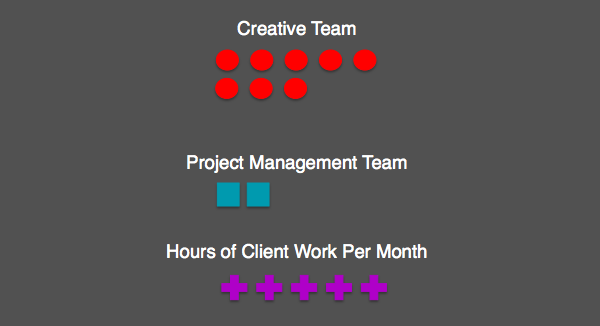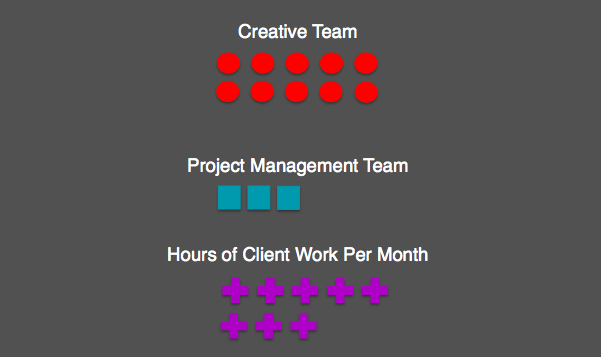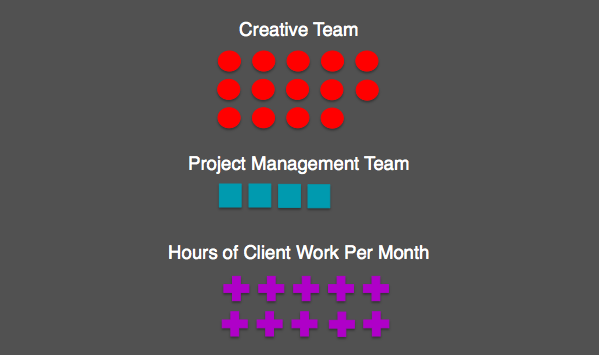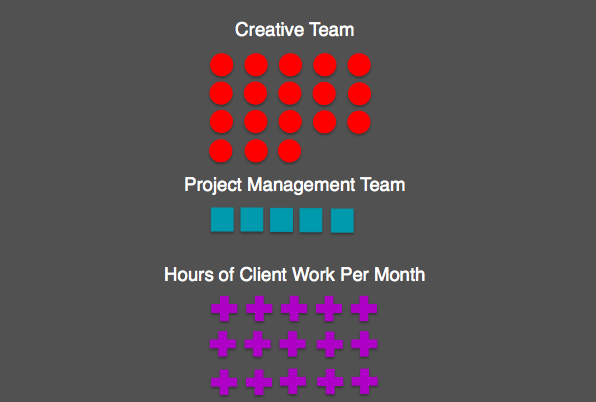Marketing agencies use production meetings to balance the flow of client work against the available capacity on their production team to fulfill the work. Over the last two years I’ve been lucky enough to participate in an evolving production meeting structure experiment at a growing agency.
Here’s the story of trying out five different production meeting formats in order to cope with growing a team from 10 people to 23. What worked, what didn’t, and what’s still up in the air.
No Meetings
At the beginning we had an 8 person production team, of which two were interns. There were two project managers. And there were no production meetings. We used Basecamp (project management system) to keep all our projects organized, and there was not a whole lot of communication between the project management team and the production team. Just assignments and impromptu meetings as needed, but no meetings were consistently scheduled. Project managers would chat briefly if they both needed the same designer on the same day for different projects.
Pros
- No meetings.
Cons
- No structured communication between project management and the production team.
- Its basically survival of the fittest project. If your project was closest to deadline or had the most demanding client screaming for it, then it plowed through the rest of the projects, throwing everything in its wake behind schedule. There was no opportunity to discuss the impact of a project on the overall production schedule.
One Meeting Per Week
While having no meetings was basically a non-stop party, we realized the project management team was not doing a good job forecasting the future demands on the production team. Additionally, the project management team and the sales team were not talking about big projects that were coming down the pike. This lack of visibility caused scheduling conflicts, sometimes left the production team with no work, and sometimes jeopardized delivering client work on time. Therefore we resolved to have one meeting per week (project managers only), on Monday mornings, to look at what was already in the production team’s pipeline and what new projects (from sales) would soon be joining them.
Pros
- Provided better visibility into production scheduling.
- Increased communication between project management and sales.
Cons
- It’s a meeting.
- A lot can change in a week.
- No structured communication between project management and the production team.
Daily Morning Project Management Meetings Followed By a Full Team Meeting
At this point our team and client work had grown significantly. We liked how the weekly meeting was going, however we realized that what looked like a reasonable production schedule on Monday changed quickly by midweek. It’s just the nature of agencies, or any business really. Some projects just don’t wrap up on schedule, what was supposed to be finished by Tuesday pushed into Wednesday, and then Wednesday’s tasks get pushed to Thursday and so on. Sometimes (read: all the time) a client who wasn’t even on the schedule that week calls with an emergency project that needs to be done within 24 hours, and that pushes other projects further down the line. It happens. The project management team needed to meet more often to adapt and adjust the schedule as needed.
At this point we also received feedback from the production team that they would appreciate having more visibility into what was coming their way. They were also curious about what projects we had in the sales pipeline. In short, the production team wanted to be kept in the loop about what was going on at the agency as a whole. Also, the production team wanted to know not just what they were doing that day individually, but they wanted to know what other production team folks were working on too. They felt if Designer A knew what Designer B was working on that day then maybe Designer A could share some production advice or direction and improve Designer B’s project.
Thus we began full team production meetings. The project managers would meet together first thing in the morning to schedule out that day, and once the day was scheduled, the project managers would sit down with the full production team for a daily meeting. In this meeting the project managers would tell the production team what was planned and who was working on what.
Pros
- Full and open communication between all teams.
- Team building, increased frequency of communication improved relationships across teams.
- Allowed production team to voice concerns over production schedule.
- Increased opportunities for cross communication between production team members to increase collaboration on projects.
- Showed the value of the project management team to the production team. While the production team creates tangible work for all can see, the project management team’s work is less tangible and thus often overlooked. By showing the full team the sheer volume and velocity of work being managed, new respect was gained for the project management team.
Cons
- It’s a daily meeting.
- Actually it’s two daily meetings (for the project managers).
- It doesn’t scale as the team grows.
- It’s expensive to have 18 people not billing for 15 minutes every single day. That’s 4.5 hours of billable time lost every morning!
- It can be boring to sit in a circle listening to what everyone else is working on.
- It created the false pretense that “the day didn’t start” until the production meeting happened.
AM Meeting Then Individual One-On-One Meetings
At this point, our team grew too large for the old meeting structure. It began taking too long to sit around and go through each person’s daily task list as a full group. So we resolved to meet individually. The project managers still met first thing in the morning before the meeting with the full production team. But now, the project managers divided up the production team and each project manager then met with 2-3 members of the production team to go over their tasks for the day.
Pros
- Helped build rapport between project managers and production team thanks to one-on-one time.
- One-on-one communication allows production team to voice concerns individually that they may not have voiced to the entire group.
Cons
- It’s a daily meeting.
- Actually it’s two daily meetings (for the project managers).
- Very time consuming.
No Meetings. Everyone Checks Their List.
As our team continued to grow, the time being invested around the two daily morning meetings (both the project manager’s meeting and the following production team meeting) became concerning. At this point we were around a 23 person agency altogether, so if we tied up our team for even 15 minutes on daily basis for a meeting it’s the equivalent of wasting 5.75/hours of billable time per day (172.5 hours/month!).
Given the apparent waste of hours, we took a bold step and killed both meetings entirely. No more daily project management meetings and no more daily meetings with the production team. We instead resolved to lean more on our project management system Basecamp. Each day the project managers were instructed to update their projects and the production team members assigned to them on Basecamp. Each project manager assigns a priority to their project as a 1 (must be done today), a 2 (could be pushed to tomorrow, but due very soon), and a 3 (not a priority at all, but needs to be done eventually). Each project manager also attaches the allotted time for the task to each task on the list.
Then, one project manager is assigned full responsibility for the overall production schedule and sorting through all 1’s, 2’s, and 3’s every day, moving tasks around based on priority and hours allocated to the task. Here’s an example of how it might look:
Joe Designer’s lists of tasks for Monday:
- 1 – Design New Landing for Client A (2 Hours)
- 2 – Design Print Ad for Client B (2.5 Hours)
- 2 – Work on Homepage Design Direction (3 Hours)
- 3 – Work on Whitepaper Cover Design (.50 Hours)
Pros
- No meetings.
- Planning still happens thanks for increased email communication between project managers, all chiming in on the same list.
- Given the production team wanted more visibility into each other’s projects, cancelling the daily production meeting sparked them to schedule their own team meeting focused on only reviewing their team’s projects.
Cons
- Less face time between team members.
- While project managers communicate around daily tasks, there is less long term planning.
- Project managers have less awareness of one each other’s overall projects.
- The production schedule gets jammed up with multiple #1 priorities for the same production team member on the same day.
So Many Meetings
So do we finally have it all figured out? Is the last format mentioned here the winner? No, of course not. A growing team and growing client workload calls for continually re-assessing how your agency works.
After trying out all these different production meeting formats, I’ve learned several things:
- Meetings are a time suck and expensive.
- That said, planning is a necessary time suck if you want to be a successful agency.
- People want more visibility than just what is on their own plates. As a team it’s important everyone is kept in the loop on what is going on at the agency as a whole.
The best thing I’ve learned is to never stop evaluating and improving. What worked a year ago, no longer works today. Don’t settle for old legacy process, don’t get caught up in “the way we’ve always done things.” What’s important is to always re-assess, to always strive to improve. What makes an agency sustainable over the years is their ability to continually work on themselves by always dedicating time to improving and not getting so caught up in client work that they put their agency’s issues or goals on the back burner.
Want more agency know-how? Check out these posts:






